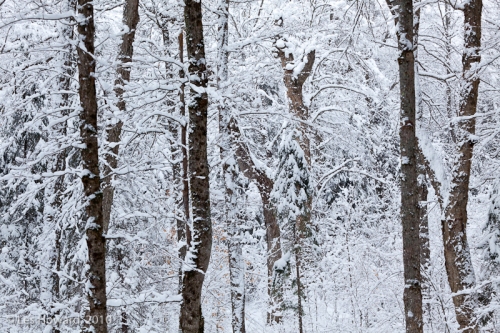It’s December. The leaves have fallen and the trees are bare. Here in the southern Ontario snowbelt we had several early dustings of snow but they all soon melted off. Although our first major snowfall was late this year, it’s now here to stay and we will not see the grass again until at least March, maybe April. The Friends of Algonquin started their Facebook album of 2010 winter photography a month ago on November 5. Algonquin Park, about a two hour drive north of here, is my favorite photography destination even in winter. I took my first winter trip there on December 4-5 this year.
I’m often asked for advice about photographing in winter so I thought I’d share some of my favorite tips in a series of articles. Here are a few to get you started. If you have a specific question about winter photography you’d like answered, ask in the comment section.
Condensation
This is so important I’ve listed it first. Condensation can disable a camera or lens for hours. It occurs when warm, humid or moisture laden air meets a cold surface. Like when you breath on a cold window and it fogs up. The fog might stay there for hours or even freeze into ice like on your car windshield. You don’t want that to happen to your camera and lens especially on the inside where you might not be able to see it or do anything about it.
So don’t breath on your lens or camera if you can avoid it. And don’t try to blow snowflakes off the front of your lens; use a lens brush or Rocket Blower.
Some people advocate putting their equipment in a sealed plastic bag before bringing it back into a warm building but I simply put everything in my camera case and zip it up. I leave it closed for several hours or even overnight until everything warms up to room temperature. Before sealing the camera bag, I take out all the batteries so they can be recharged and also the memory cards so they can be warmed up and off-loaded to my computer.
I often put my camera bag over a heater vent to speed up the warming process. If I decide to go back outside I either leave the bag outside so it stays cold or simply take it back out without opening it inside.
Batteries
Even before the temperature gets down to the freezing mark, you will start to experience problems with batteries. The colder your batteries get, the faster the power will drain. There are several ways to handle this problem. I like to carry a couple of fully charged backup batteries in a nice warm pocket inside my coat. As soon as the battery in the camera starts to give me any problems. I replace it with a warm one and put the used one in my pocket to warm back up so I can reuse it later.
You can extend the battery life by cutting down on your power consumption. The LCD uses a lot of power so keep the display turned off when you don’t need it. Don’t use Live View if you don’t need it. The same goes for Image Stabilization. Those of us with failing eyesight love Autofocus but it, too, can use a lot of power. I use the center spot to focus a scene then turn AF off when I recompose moving my subject off the spot. This may require a tripod.
At the end of the shooting day, I take all the batteries inside and fully recharge them so they’ll be ready for the next day. I keep a power inverter in my car so I can partially recharge them when I’m driving from one location to another. The inverter only works when the engine is running so this is not very effective if you’re only going short distances. I purchased the inverter from the computer department at Staples.
Tripods
Metal tripods get cold. They can be painful to touch with bare skin. I wrap my tripod legs in ensolite foam pipe insulation that I purchased from Home Depot and Lowe’s. This insulation comes in various diameters so you need to take your tripod into the store to find the size that fits. I cut the insulation to length using a box cutter type knife, put it on the top section of the tripod legs then wrap it end to end using black vinyl electrical tape. I leave it on my tripod year round because it also cushions my shoulder when I carry it. The insulation will last for many years without needing to be replaced. Also, it does not add any significant weight to the tripod.




